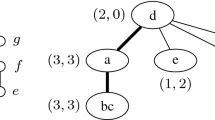Abstract
We analyze two essential problems arising from edge-based graph partitioning. We show that one of them is an NP-hard problem but the other is in P, presenting a novel methodology that links linear algebra theory to the graph problems as a part of proving the facts. This is a significant trial in that linear algebra, which has been mostly adopted as a theoretical analysis tool, is practically applied to solving actual graph problems. As a result of the linear algebraic manipulation, we could devise a linear-time algorithm for the problem in P.
Similar content being viewed by others
References
Alpert, C.J., Kahng, A.B.: Recent directions in netlist partitioning: a survey. Integration, the VLSI Journal 19(1–2), 1–81 (1995)
Bui, T.N., Jones, C.: Finding good approximate vertex and edge partitions is NP-hard. Inf. Process. Lett. 42(3), 153–159 (1992)
Clark, L.H., Shahrokhi, F., Székely, L.A.: A linear time algorithm for graph partition problems. Inf. Process. Lett. 42(1), 19–24 (1992)
Feige, U., Karpinski, M., Langberg, M.: A note on approximating Max-Bisection on regular graphs. Inf. Process. Lett. 79(4), 181–188 (2001)
Fjällström, P.O.: Algorithms for graph partitioning: a survey. In: Linkoping Electronic Articles in Computer and Information Science, vol. 3 (1998)
Hagen, L., Kahng, A.B.: New spectral methods for ratio cut partitioning and clustering. IEEE Trans. Comput.-Aided Des. Integr. Circuits Syst. 11(9), 1074–1085 (1992)
Kim, Y.-H., Moon, B.-R.: Lock-gain based graph partitioning. Journal of Heuristics 10(1), 37–57 (2004)
Kučera, L.: Expected complexity of graph partitioning problems. Discrete Appl. Math. 57(2–3), 193–212 (1995)
Powers, D.L.: Graph partitioning by eigenvectors. Linear Algebra Appl. 101, 121–133 (1988)
Yan, J.-T., Hsiao, P.-Y.: A fuzzy clustering algorithm for graph bisection. Inf. Process. Lett. 52(5), 259–263 (1994)
Antonio, S.M., Abraham, D., Juan, J.P., Raúl, C.: High-performance VNS for the max-cut problem using commodity graphics hardware. In: Proceedings of the 18th Mini Euro Conference on VNS (2005)
Cong, J., Labio, W.J., Shivakumar, N.: Multiway VLSI circuit partitioning based on dual net representation. IEEE Trans. Comput.-Aided Des. Integr. Circuits Syst. 15(4), 396–409 (1996)
Guattery, S., Miller, G.L.: On the quality of spectral separators. SIAM J. Matrix Anal. Appl. 19(3), 701–719 (1998)
Michel, J., Pellegrini, F., Roman, J.: Unstructured graph partitioning for sparse linear system solving. In: Proceedings of the 4th International Symposium on Solving Irregularly Structured Problems in Parallel, pp. 273–286 (1997)
Venkatakrishnan, V.: Parallel computation of Ax and A T x. Int. J. High Speed Comput. 6, 325–342 (1994)
Boese, K.D., Kahng, A.B., Muddu, S.: A new adaptive multi-start technique for combinatorial global optimizations. Oper. Res. Lett. 15, 101–113 (1994)
Jones, T., Forrest, S.: Fitness distance correlation as a measure of problem difficulty for genetic algorithms. In: Proceedings of the Sixth International Conference on Genetic Algorithms, pp. 184–192 (1995)
Sorkin, G.B.: Efficient simulated annealing on fractal landscapes. Algorithmica 6, 367–418 (1991)
Weinberger, E.D.: Fourier and Taylor series on fitness landscapes. Biol. Cybern. 65, 321–330 (1991)
Kim, Y.-H., Seo, K.: Two congruence classes for symmetric binary matrices over \(\mathbb{F}_2\). WSEAS Trans. Math. 7(6), 339–343 (2008)
Biggs, N.L.: Algebraic Graph Theory. Cambridge University Press (1974)
Diestel, R.: Graph Theory, Number 173 in Graduate Texts in Mathematics, 2nd edn. Springer, New York (2000)
Hoffman, D.G., Leonard, D.A., Lidner, C.C., Phelps, K.T., Rodger, C.A., Wall, J.R.: Coding Theory: The Essentials. Marcel Dekker (1991)
van Lint, J.H.: Introduction to Coding Theory, 3rd edn. Springer (1998)
Armbruster, M., Fügenschuh, M., Helmberg, C., Jetchev, N., Martin, A.: Hybrid genetic algorithm within branch-and-cut for the minimum graph bisection problem. In: Evolutionary Computation in Combinatorial Optimization, pp. 1–12 (2006)
Aho, A.V., Hopcroft, J.E., Ullman, J.D.: The Design and Analysis of Computer Algorithms. Addison Wesley (1974)
Ford Jr., L.R., Fulkerson, D.R.: Flows in Networks. Princeton University Press (1962)
Vardy, A.: The intractability of computing the minimum distance of a code. IEEE Trans. Inf. Theory 43(6), 1757–1766 (1997)
Author information
Authors and Affiliations
Corresponding author
Rights and permissions
About this article
Cite this article
Yoon, Y., Kim, YH. & Moon, BR. A Note on Edge-based Graph Partitioning and its Linear Algebraic Structure. J Math Model Algor 10, 269–276 (2011). https://doi.org/10.1007/s10852-011-9154-4
Received:
Accepted:
Published:
Issue Date:
DOI: https://doi.org/10.1007/s10852-011-9154-4




